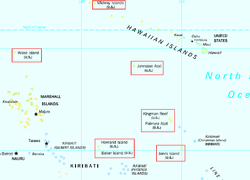United States Minor Outlying Islands
|
United States Minor Outlying Islands |
|
|---|---|

Flag
|
|
|
Motto:
|
|
|
Anthem: "The Star-Spangled Banner"
|
|

Locations of the United States Minor Outlying Islands in the Pacific Ocean; note that Navassa Island is not visible on this map.
|
|
| Administrative center | Washington, D.C. |
| Largest village | Wake Island |
| National language | English |
| Demonym |
|
| Government | |
| Donald Trump (R) | |
|
• Director, United States Fish and Wildlife Service
|
Daniel M. Ashe |
| Area | |
|
• Total
|
34.2 km2 (13.2 sq mi) (190th) |
|
• Water (%)
|
88.6 |
| Population | |
|
• 2009 estimate
|
300 (232nd) |
|
• 2000 census
|
316 |
| GDP (PPP) | estimate |
|
• Per capita
|
$46,381a (6th) |
| Currency | United States dollar (USD) |
| ISO 3166 code | UM |
| Internet TLD | .us b |
|
|
The United States Minor Outlying Islands, a statistical designation defined by the International Organization for Standardization's ISO 3166-1 code, consist of eight United States insular areas in the Pacific Ocean (Baker Island, Howland Island, Jarvis Island, Johnston Atoll, Kingman Reef, Midway Atoll, Palmyra Atoll, and Wake Island) and one in the Caribbean Sea (Navassa Island).
Among them, Palmyra Atoll is the only incorporated territory. As of 2017[update], none of the islands have any permanent residents. The only human population consists of temporarily stationed scientific and military personnel. The 2000 census counted 315 people on Johnston Atoll and 94 people on Wake Island.
There has been no modern indigenous population, except at the 1940 census. In 1936 a colonization program began to settle Americans on Baker, Howland, and Jarvis, but all three islands were evacuated in 1942 as a result of World War II.
...
Wikipedia
